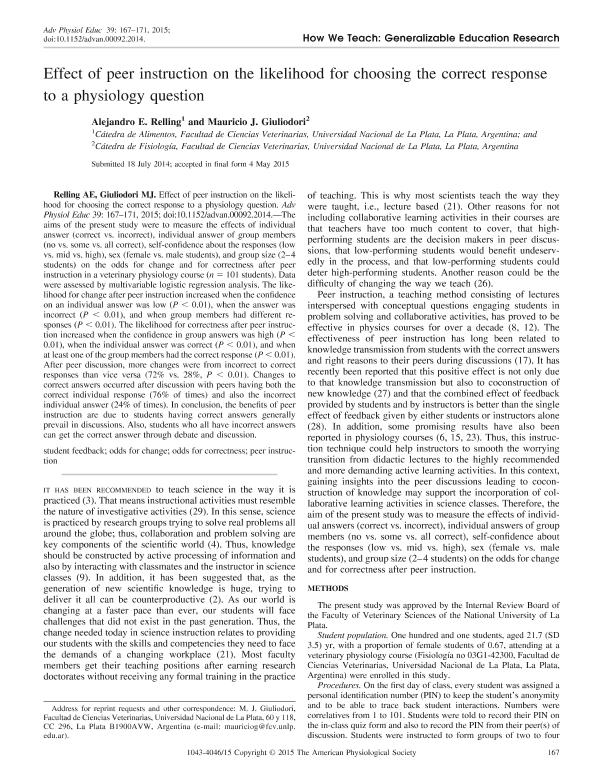Mostrar el registro sencillo del ítem
dc.contributor.author
Relling, Alejandro Enrique

dc.contributor.author
Giuliodori, Mauricio Javier

dc.date.available
2018-06-11T20:20:32Z
dc.date.issued
2015-09
dc.identifier.citation
Relling, Alejandro Enrique; Giuliodori, Mauricio Javier; Effect of peer instruction on the likelihood for choosing the correct response to a physiology question; American Physiological Society; Advances In Physiology Education; 39; 3; 9-2015; 167-171
dc.identifier.issn
1043-4046
dc.identifier.uri
http://hdl.handle.net/11336/48155
dc.description.abstract
The aims of the present study were to measure the effects of individual answer (correct vs. incorrect), individual answer of group members (no vs. some vs. all correct), self-confidence about the responses (low vs. mid vs. high), sex (female vs. male students), and group size (2-4 students) on the odds for change and for correctness after peer instruction in a veterinary physiology course (n = 101 students). Data were assessed by multivariable logistic regression analysis. The likelihood for change after peer instruction increased when the confidence on an individual answer was low (P < 0.01), when the answer was incorrect (P < 0.01), and when group members had different responses (P < 0.01). The likelihood for correctness after peer instruction increased when the confidence in group answers was high (P < 0.01), when the individual answer was correct (P < 0.01), and when at least one of the group members had the correct response (P < 0.01). After peer discussion, more changes were from incorrect to correct responses than vice versa (72% vs. 28%, P < 0.01). Changes to correct answers occurred after discussion with peers having both the correct individual response (76% of times) and also the incorrect individual answer (24% of times). In conclusion, the benefits of peer instruction are due to students having correct answers generally prevail in discussions. Also, students who all have incorrect answers can get the correct answer through debate and discussion.
dc.format
application/pdf
dc.language.iso
eng
dc.publisher
American Physiological Society

dc.rights
info:eu-repo/semantics/openAccess
dc.rights.uri
https://creativecommons.org/licenses/by-nc-sa/2.5/ar/
dc.subject
Student Feedback
dc.subject
Odds for Correctness
dc.subject
Odds for Change
dc.subject
Peer Instruction
dc.subject.classification
Otras Ciencias de la Educación

dc.subject.classification
Ciencias de la Educación

dc.subject.classification
CIENCIAS SOCIALES

dc.subject.classification
Fisiología

dc.subject.classification
Medicina Básica

dc.subject.classification
CIENCIAS MÉDICAS Y DE LA SALUD

dc.title
Effect of peer instruction on the likelihood for choosing the correct response to a physiology question
dc.type
info:eu-repo/semantics/article
dc.type
info:ar-repo/semantics/artículo
dc.type
info:eu-repo/semantics/publishedVersion
dc.date.updated
2018-06-11T14:28:35Z
dc.identifier.eissn
1522-1229
dc.journal.volume
39
dc.journal.number
3
dc.journal.pagination
167-171
dc.journal.pais
Estados Unidos

dc.journal.ciudad
Bethesda
dc.description.fil
Fil: Relling, Alejandro Enrique. Consejo Nacional de Investigaciones Científicas y Técnicas. Centro Científico Tecnológico CONICET- La Plata. Instituto de Genética Veterinaria ; Argentina
dc.description.fil
Fil: Giuliodori, Mauricio Javier. Universidad Nacional de La Plata. Facultad de Ciencias Veterinarias; Argentina. Consejo Nacional de Investigaciones Científicas y Técnicas; Argentina
dc.journal.title
Advances In Physiology Education

dc.relation.alternativeid
info:eu-repo/semantics/altIdentifier/doi/https://dx.doi.org/10.1152/advan.00092.2014
dc.relation.alternativeid
info:eu-repo/semantics/altIdentifier/url/https://www.physiology.org/doi/10.1152/advan.00092.2014
Archivos asociados
